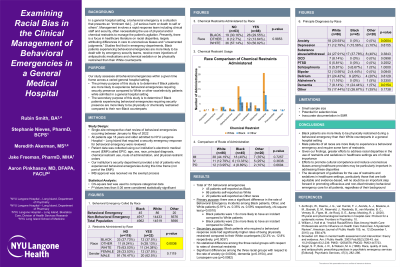Diversity, Equity, and Inclusion
Session: Poster Session
(074) Examining Racial Bias in the Clinical Management of Behavioral Emergencies in a General Medical Hospital

Trainee Involvement: Yes
- SN
Stephanie Nieves, PharmD
Pharmacist
NYU Langone Hospital - Long Island
North Merrick, New York, United States - RS
Rubin A. Smith, BA
Medical Student
NYU Long Island School of Medicine
Great Neck, New York, United States - MA
Meredith Akerman, MS
Biostatistician
NYU Long Island School of Medicine
Mineola, New York, United States - JF
Jake Freeman, PharmD, MHA
Assistant Director of Pharmacy Services
NYU Langone Health
Mineola, New York, United States - AP
Aron Pinkhasov, DFAPA, FACLP
Professor of Psychiatry and Medicine, NYU-LI-SOM
NYU-Long Island Hospital
Albertson, New York, United States
Presenting Author(s)
Co-Author(s)
Co-Author(s)
Background/Significance Management of behavioral emergencies involves a rapid response team including clinical staff and security, often necessitating the use of physical and/or chemical restraints to manage the patient’s agitation (de Bruijn, 2019). Racial bias towards African American patients receiving restraints and/or sedatives in healthcare settings has been well documented, in several settings. The field of psychiatry is no exception. Most published studies to date concern emergency department visits (Hall, 2003, Snowden, 2003, Segal, 1996, Wong, 2021); our study assesses all behavioral emergencies within a given time frame across a varied general hospital setting. Methods The primary purpose of this study is to determine if Black patients are more likely to experience behavioral emergencies requiring security presence compared to White or other race/ethnicity patients while admitted in a general hospital setting. The secondary purpose of this study is to determine if Black patients experiencing behavioral emergencies requiring security presence are more likely to be physically or chemically restrained compared to their non-Black counterparts. Our study population was a consecutive series of behavioral emergencies that occurred between January and May of 2022. Patient demographics such as age, sex, and race/ethnicity were collected, and chi-square test was used to compare categorical data. P-Values less than 0.05 were considered statistically significant. As this was a retrospective chart review, IRB approval was received under the exempt process. Results As per our primary objective, there was a significant difference in the rate of Behavioral Emergency Incidents among Black patients, Other, and White patients (0.91% vs. 0.35% vs. 0.59% respectively, p< 0.0010). As per our secondary objective, we found that Black patients who required a behavioral response code had significantly higher rates of being physically restrained compared to their White counterparts (32.3% vs. 12.8% respectively, p=0.0037). We found no statistical difference among the three racial groups with respect to rates of chemical restraints placed. Discussion Overall, our results suggest that Black patients are more likely to be physically restrained during a behavioral emergency than their White counterparts in a general hospital setting, findings consistent with previous research (Segal, 1996, Wong, 2021). Unlike previous research, however, our results suggest that these disparities extend beyond emergency department visits into a varied general hospital setting. Greater efforts to address racial disparities in the use of restraints and sedatives in healthcare settings are of critical importance. Future studies should explore populations across various general/emergency hospital settings, as well as potential interventions to address these disparities and improve the quality of care for all patients experiencing behavioral emergencies. Conclusion This study highlights the urgent need for refinement of guidelines for use of restraints and sedatives in healthcare settings—particularly in a direction that is both equitable and evidence-based—in order to promote efficacious and non-discriminatory care for all patients, regardless of their background. de Bruijn, W. et.al (2020).https://doi.org/10.3389/fpsyt.2019.00921 William J. Hall etal. (2015):10.2105/AJPH.2015.302903 Snowden LR et.al, (2003)doi:10.2105/ajph.93.2.239. Segal, S. P.et.al,https://doi.org/10.1176/ps.47.3.282 Wong AH et al, (2021)doi:10.1001/jamanetworkopen.2020.35241
(Abridged references in order to fit word count)

